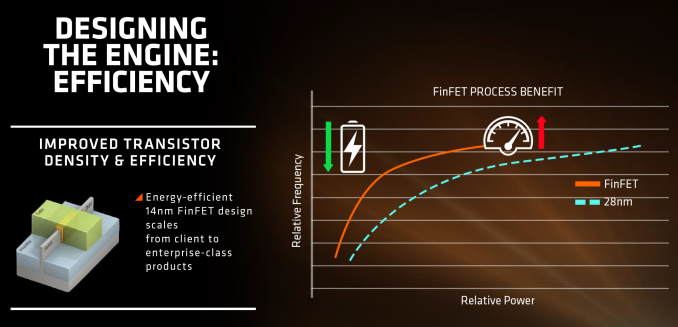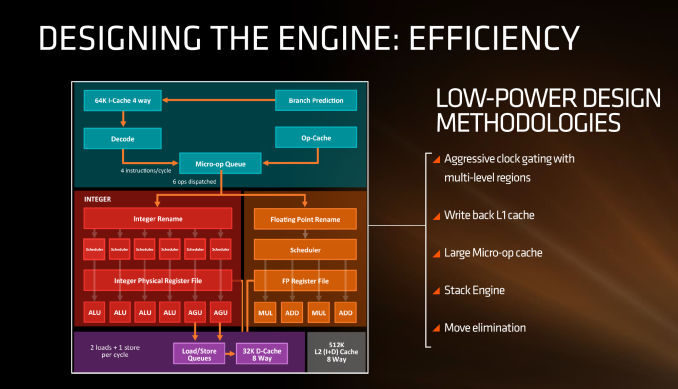AMD Zen Microarchitecture: Dual Schedulers, Micro-Op Cache and Memory Hierarchy Revealed
by Ian Cutress on August 18, 2016 9:00 AM ESTLow Power, FinFET and Clock Gating
When AMD launched Carrizo and Bristol Ridge for notebooks, one of the big stories was how AMD had implemented a number of techniques to improve power consumption and subsequently increase efficiency. A number of those lessons have come through with Zen, as well as a few new aspects in play due to the lithography.
First up is the FinFET effect. Regular readers of AnandTech and those that follow the industry will already be bored to death with FinFET, but the design allows for a lower power version of a transistor at a given frequency. Now of course everyone using FinFET can have a different implementation which gives specific power/performance characteristics, but Zen on the 14nm FinFET process at Global Foundries is already a known quantity with AMD’s Polaris GPUs which are built similarly. The combination of FinFET with the fact that AMD confirmed that they will be using the density-optimised version of 14nm FinFET (which will allow for smaller die sizes and more reasonable efficiency points) also contributes to a shift of either higher performance at the same power or the same performance at lower power.
AMD stated in the brief that power consumption and efficiency was constantly drilled into the engineers, and as explained in previous briefings, there ends up being a tradeoff between performance and efficiency about what can be done for a number of elements of the core (e.g. 1% performance might cost 2% efficiency). For Zen, the micro-op cache will save power by not having to go further out to get instruction data, improved prefetch and a couple of other features such as move elimination will also reduce the work, but AMD also states that cores will be aggressively clock gated to improve efficiency.
We saw with AMD’s 7th Gen APUs that power gating was also a target with that design, especially when remaining at the best efficiency point (given specific performance) is usually the best policy. The way the diagram above is laid out would seem to suggest that different parts of the core could independently be clock gated depending on use (e.g. decode vs FP ports), although we were not able to confirm if this is the case. It also relies on having very quick (1-2 cycle) clock gating implementations, and note that clock gating is different to power-gating, which is harder to implement.












216 Comments
View All Comments
Zingam - Thursday, August 18, 2016 - link
AMD realized finally that there is nothing better in the x86 world than copying Intel.tarqsharq - Thursday, August 18, 2016 - link
The same way Intel copied x86-64 from AMD? Or how AMD put out a superior dual core solution?Copying has gone both ways.
Stuka87 - Thursday, August 18, 2016 - link
Intel did not copy x86-64, they licensed it from AMD.Krysto - Thursday, August 18, 2016 - link
Which by the way is one of the reasons why the argument that "Intel would never allow AMD to be sold to another company" is so STUPID. If they do something like that and somehow retract their own licensing to AMD, let's see how well Intel does in the market without the 64-bit support licensed from AMD......That's why I believe AMD could easily sell itself to Qualcomm or Samsung if it wanted to. Intel may throw a hissy fit, but at the end of the day there's nothing they can do about it. Worst case scenario, whoever buys AMD, has to pay a little more for Intel's IP, but nothing that would break the company.
Kvaern1 - Thursday, August 18, 2016 - link
The licensing agreement is automatically terminated if either part goes through a change of control.Piraal - Thursday, August 18, 2016 - link
If intel wasn't licensed then it would be monopoly for AMD in no time, ever wonder why they licensed intel?Guess what intel licensed x86 to AMD before that for the same reason. It is funny how few people understand why AMD, and Intel before that 'had' to essentially give up something that would destroy their biggest competitor.
Morawka - Thursday, August 18, 2016 - link
IIRC if was part of a settlement between AMD and Intel that lead to the x64 getting licensed. i could be wrong thoSamus - Friday, August 19, 2016 - link
Actually the way I last read the licensing agreement worked is as long as AMD licenses x86, Intel has exclusive use of any AMD innovations in x86. That's how Intel essentially "licensed" x86-64 for free.It's like Mazda licensing a platform to Ford to build, and in return Mazda is allowed to monitor improvements to the platform to use on their own vehicles. This is commonly referred to as a joint venture technology agreement, and although AMD and Intel don't call it that, it's what it appears to be because the fine print of Intel licensing permits them to peak inside architectural improvements.
Note that this has nothing to do with the manufacturing end, unlike my Mazda>Ford analogy which is exclusively manufacturing based.
Anato - Saturday, August 20, 2016 - link
"Actually the way I last read the licensing agreement worked is as long as AMD licenses x86, Intel has exclusive use of any AMD innovations in x86. That's how Intel essentially "licensed" x86-64 for free."I doubt this, as this would mean that terminating AMD would terminate Intel x86-64 license. Think IBM, Samsung, Oracle or Apple buying AMD and stop making x86. Then Intel would not have x86-64 license anymore. So by paying 5-10B$ for AMD you could stop Intel's current 64 license which is >70% (?) of their revenue or use this as ransom.
Samus - Saturday, August 20, 2016 - link
All past-tense licensed innovation is grandfathered in upon a technology agreement termination. Legally. For instance, Mazda and Ford can use each others previous platforms indefinitely.